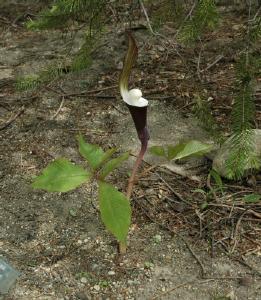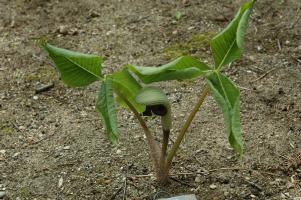What are Arisaema doing in winter? Those outdoors in the ground are fast asleep right now. The seedlings I am growing on from seed distributed by the Arisaema Enthusuast Group (AEG), also known as Arisaema-L on NIC.SURFNET.NL, are growing under lights in my basement.
Arisaema are slow-growing perennials in the Aroid Family (Araceae) found in the Northern Hemisphere in Asia and in North America. For the most part, they are woodland and forest plants. They vary widely in hardiness, from the North American species Arisaema triphyllum and the Siberian A. amurense, both very hardy, to the tropical species native to southeast Asia, which are quite tender in cold climates.
Arisaema hobbyists have found that you can accelerate the growth of Arisaema from seed by alternating periods of active growth of 3 or 4 months duration with periods of dormancy of 3 or 4 months length. I grow my seedlings in pots under lights in my basement for the growth pahse of this cycle. Then I let them dry out and lose their leaves. They go into an old working refrigerator to be stored at about 40°F for 3 or 4 months. This past year, I planted seeds in December 2006 and January 2007. In May, I dried the pots off and moved them into the refrigerator. In early September, I moved them back to room temperature, set them under the fluorescent lights, and started watering them again.
One variety, Arisaema yunnanense aridum, was planted in January 2006 and has gone through about three complete cycles. Now it is blooming. Granted, the blooms are unspectacular so far; still it has reached bloom size in two years instead of three or four. Other species started at the same time are mostly still much to small to bloom, so they will have to undergo this accelerated cycle several more times.
There are some more attractive and interesting Arisaema species that are hardy or nearly hardy here in central Indiana. The most spectacular is surely Arisaema sikokianum.

 Arisaema sikokianum (right) and Arisaema ringens (left) are both reasonably hardy here in Indiana. This year, neither of them bloomed. Both were planted in late 1999, so they did well for at least six years, through 2005. They grew under Sugar Maple trees in heavy shade. Now it seems time to replace them with fresh tubers.
Arisaema sikokianum (right) and Arisaema ringens (left) are both reasonably hardy here in Indiana. This year, neither of them bloomed. Both were planted in late 1999, so they did well for at least six years, through 2005. They grew under Sugar Maple trees in heavy shade. Now it seems time to replace them with fresh tubers.
There are a couple other species that seem to be doing fairly well outdoors here. A. heterophyllum was doing well as of spring 2007. It is growing in a sunny spot that gets some afternoon shade.
You can start Arisaema from seeds any time of year, if you can grow them indoors. Only the seeds of a couple species, like A. triphyllum and possibly A. amurense, require cold damp treatment ("stratification" is the technical term for this) to induce germination. All the others germinate very readily at room temperature with little more than an overnight soak in tap water before being planted.
I plant my Arisaema seeds in pots from 6 to 10 inches in diameter, depending on how many seeds I ahve of a given species. I plant them in one of my two usual mixes, the sandy mix (Promix BX Biofungicide + sand, 2 : 1 by volume) or the gritty mix (Promix BX Biofungicide + sand + granite grit, 2 : 1 : 1 by volume). I normally cover the seeds and the potting mix with about 1/2 inch layer of the same sand used in the potting mixes. The pots are set in water almost up to their rims, to wet the potting mix thoroughly, the set in a sauce and placed under the fluorescent lights in the plant room.
Good gardening,
Jim